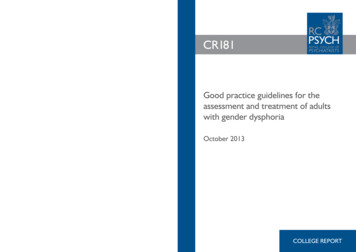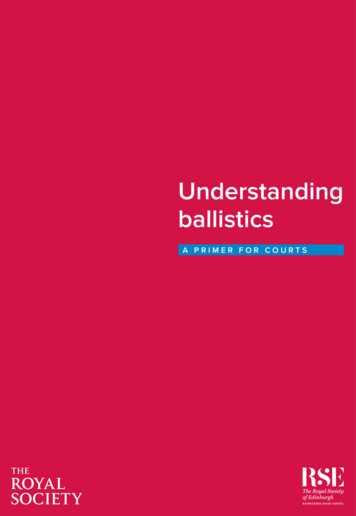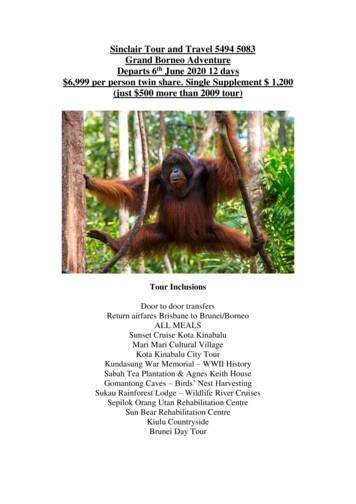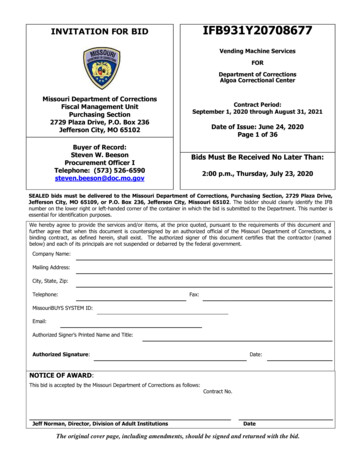
Transcription
Whisky chemistryA whisky tourJUPITER IMAGESIs this the most chemically complicated drink in the world? Victoria Gill attemptsto unlock some of the mysteries of Scotch malt whisky40 Chemistry World December 2008www.chemistryworld.org
Making flavourWhiskies contain hundreds ofcompounds, including fatty acids,esters, alcohols, and aldehydes, ina wide range of concentrations.According to Paul Hughes, directorof the International Centre forBrewing and Distilling (ICBD)at Heriot-Watt University inEdinburgh, the most importantflavours in a whisky come from‘the raw materials, the distillationprocess, and the maturation’. Sothat’s the whole whisky-makingprocess, then – and there’s just nonarrowing it down.To begin at the beginning,we need to go back to the rawmaterials. That’s Scotch whisky10, 12, 16 or more years before it’spoured into your glass. The ScotchWhisky Act quite literally laysdown the law about raw materialsand the production process.1 Scotchmalt whisky is made from 100 percent malted barley – grain thathas been germinated very briefly,releasing the enzymes that convertstarch into the sugar that eventuallybecomes alcohol.Whisky-producers start with amash of malt and water. (Underthe Act, distillers must use thatwater as it arrives at their distillery,untreated in any way). The aimis to turn as much of the grain’swww.chemistryworld.orgstarch into sugar as possible, for thehighest alcohol yield.The strong sugar solution istaken from the mash, and yeast isadded for fermentation. This takesabout 72 hours, after which thealcoholic solution – or wash – goesfor distillation.This is where those impressive,bulbous copper stills come in.Distillation is essentially verysimple – heating the mixture toseparate it into fractions basedon their volatility – althoughthe copper also catalyses someimportant reactions on the side.And as with any scaled-up process,there are a lot of variables. Reflux,for example, is determined by theneck of the still, so its shape is veryimportant, and each distillerydesigns its own.‘Copper catalyses the reactionsyou want most in distillation– especially those reactions thatremove sulfurous compounds,’explains Craig Owen, a chemist andlaboratory manager at the SWRI.The research at the SWRI isfunded by its members – Scotchmalt whisky producers – who areconstantly refining the efficiency oftheir processes. ‘What distilleriesare looking for is continuity,’ saysOwen. ‘They want to understandeach part of the process, so that ifanything starts to drift they knowexactly where the problem will be– to get it back on track again.’ The finely-tunedDistillation of the spirit givesprocess of Scotch whisky three fractions – the foreshotsproduction is governed by that contain the highly volatileits own law – the Scotchcomponents such as acetaldehydeWhisky Actand ethyl acetate, the spirit There are 92 maltfraction that will go on to bewhisky distilleries inmatured into Scotch, and the feintsScotland, and each onewhich contain the low volatilityhas a slightly differentcompounds, including phenolsprocess – with differentand many nitrogen-containingstills, malts and casks for compounds. Foreshots and feintsmaturationare removed but, since they contain Under the Act, Scotch alcohol, they are recycled andwhisky must be matured redistilled.for at least three years,‘Most Scotch whisky is distilledduring which timetwice,’ explains Brian Eaton, seniorthe spirit reacts withteaching fellow at the ICBD. ‘That’scompounds in the timber a key difference between Irishcaskswhiskey and Scotch. Irish whiskey Chemists continueis triple-distilled, and that’s a bigto study the complexmarketing point – its purity. But theeffects of dilution on the thing about double-distilling is thesensory perception offlavour compounds that remain inwhisky flavoursthe whisky. You could say that theaim with Scotch whisky is to distil itjust enough.’In shortMaturation casks –where up to 16 years ofchemistry takes placeThe spice of lifeThere are 92 malt distilleries inScotland, all unique. Each takes aslightly different fraction duringdistillation – so each spirit ischemically different before it evengets into the cask to mature. Thiscolourless liquid already containsMACDUFF EVERTON / CORBISWhen I worked in a tiny Edinburghpub, I occasionally incurred thewrath of the regulars when thewater jug sat on the bar wasn’t atroom temperature by the time theywanted their whisky. So I’ve longbeen eager to find out if there’s anychemical truth behind this receivedbar wisdom, and similar whiskylore.I’ve heard much postulatingabout ‘releasing the flavours’, soduring my visit to Edinburgh’sScotch Whisky Research Institute(SWRI), I hoped the real expertsmight teach me how to make it – orfake it – as a whisky connoisseur, sothat I could smugly explain to myfriends in the pub exactly how oneshould dilute one’s whisky – andmore importantly, why.But embarking on a whirlwindtour of whisky chemistry raisedfar more questions than I couldhave predicted. Like the heady,aromatic spirit itself, it’s far fromsimple. There’s no single chemicalcomposition to describe a whisky,so there’s no single way to explainwhat exactly happens in your glasswhen you add water, ice or even(heaven forfend) cola.Chemistry World December 2008 41
Whisky chemistryNot all distilleries smoke their malt – but some,including Laphroaig, Ardbeg and Lagavulin, allon the Scottish island of Islay, are famous for it.It’s a practice derived from the days when peoplewould dry out their malted barley over a peatfuelled fire, simply because peat was an easilyand locally accessible fuel. Phenolic compoundstransfered from the peat give these whiskiestheir signature smoky flavour.But even peat chemistry is complex. BarryHarrison, a distillation researcher at the SWRI,has studied different peats and found that thechemical composition of a peat bog depends onits geographical location. ‘So I tried to find out ifwe could match that to chemical fingerprint ofthe spirit,’ says Harrison.He dug peat samples from six locationsacross Scotland – three of which were peat bogson Islay. ‘I smoked malt in the fume cupboard in alab, then distilled my own spirit with it.’ Harrisonused a combination of analytical techniques tostudy his peat samples and smoked malt, andeven volunteer nosers to test his lab-made spirit.He found not only that peat from differentsome of the compounds thatare evident in the final flavour –phenols, esters, lactones, aldehydessome sulfur and nitrogencontaining compounds.But the cask is where the reallyinteresting stuff happens – with thematuration process finely tunedto each individual whisky. ‘Whenyou mature a Scotch, you’re tryingto balance the spirit character withthe maturation character,’ saysEaton. ‘Some may be matured foreight years, but most of the verysmoky malts are matured for 12 to16 years – because it takes longer toget the balance right.’Most casks are made of Americanwhite oak, and have already beenused once to make bourbon. ‘TheAmerican bourbon industry usesnew casks every time, so it’s a cheapand efficient way to buy them,’says Eaton. Bourbon-making isalso a good pre-treatment forthe casks. White oak contains alot of vanillin – the compoundresponsible for the sweet, vanillanote that is a signature of bourbon.Making bourbon extracts a lot ofthe vanillin from the casks, and onlythen are they ready for Scotch.All casks must be less than700 litre capacity, because much ofthe maturation chemistry dependson good contact with the wood.Three types of reaction happenin the cask – additive, subtractiveand interactive. In subtractivereactions, compounds are lostthrough the timber – including the42 Chemistry World December 2008MACDUFF EVERTON / CORBISSmoky notesEach peat bog on Islay adds a unique flavour signature to the final whiskybogs could be distinguished by its chemicalfingerprint, but that the chemical fingerprint ofa bog was still distinguishable in the final spirit.It’s just one example of a practice steeped inpungent sulfur compounds, such asdimethyl sulfide.And as oxygen diffuses intothe cask, reactions take placebetween the molecules in thespirit, and between the spirit andthe wood. Alcohols and aldehydesare oxidised, and acids react withethanol to form esters – whichare some of the most aromatic ofwhisky flavour compounds.The casks are often fired tochar the inside. The resultinglayer of active carbon on the innersurface removes some unwantedcompounds, and charring starts thebreakdown of lignin in the wood.‘Lignin undergoes what’s beentermed ethanolysis,’ says JohnPiggott from the University ofStrathclyde. ‘Ethanol reacts withthe lignin to break it down intosome of the important flavourcompounds, such as aromaticaldehydes.’ Piggott has comparedcharred with uncharred oak in thematuration of Scotch malt whisky,and found that charring increasedthe production of whisky lactones(cis- and trans-methyloctalactone)– fruity flavour compounds oftendescribed as smelling like coconut.2And it’s maturation in timbercasks that gives the whisky itsgolden colour. Melanoidins – fromthe breakdown of cellulose – helpto brown the spirit. And somedistilleries use old sherry or rumcasks, which also darken thewhisky, as well as contributing to itsflavour. The only additive allowed,tradition that plays a part in the mysteriouschemistry of malt whisky.ReferenceB Harrison et al, J. Inst. Brew., 2006, 112, 333apart from water, is caramel, whichcan be added to bring the whisky toa standard colour.‘The aim withScotch whiskyis to distil it justenough’Age is everythingThe Act states that whisky is notScotch whisky until it has beenmatured for at least three years.And that it must be matured inScotland. ‘This isn’t the industrybeing protectionist,’ says Eaton. ‘It’sdown to the climate – it’s cold anddamp, which affects maturation. Inthe US, the ethanol concentration inthe cask goes up because it’s hot anddry, here it goes down.’Once a whisky has matured, itis blended and diluted for bottling– cask strength whisky can be morethan 60 per cent ethanol, and thefinal bottled spirit is 40 per cent.Each distillery has a master blender– a person able to detect hundredsof flavour compounds by nosealone. This is still a talent no pieceof analytical equipment can match,and everyone interviewed for ajob at the SWRI is asked to take asmelling test to see if they could jointhe institute’s panel of 19 nosers.Single malts are usually blendedfrom several casks – all from thesame distillery – to establish just theright flavour. The age on the bottleindicates the youngest whisky inthat blend.Eaton says the belief that singlemalt whiskies are far superior towhat we commonly refer to asblended whiskies is something ofa misconception. ‘From aroundwww.chemistryworld.org
cs. People think blendsare cheap and nasty and they’re not,many of them are superb.’How to drink whiskyJust as diverse and complex are theways in which whisky is consumed.But single malt purists will oftentell you to add just a little eryOSweetAssociated HoneyWoodPhenols AssociatedWood-smokeOHOAldehydes sky tasters can use‘flavour wheels’ to assessthe complex mixture ofcompounds that make upeach individual whiskyCHOtemperature water. So is that the‘right way’ to drink whisky?‘It’s personal preference – thereare no instructions on the bottlethat say “dilute to taste”,’ Owenpoints out diplomatically. ‘It’s partlyabout practicality. When we’renosing the whisky, it’s diluted to 20per cent [ethanol concentration]MACDUFF EVERTON / CORBIS1890 to the 1960s everyone drankblended whisky,’ says Eaton. Thelate 1800s are significant becausean aphid-related pest calledphylloxera, accidently importedfrom America, had wiped out thegrapevines across France and therest of Europe.‘People in the UK who drankbrandy couldn’t get it, so theylooked to Scotland where they weremaking this very fiery spirit calledmalt whisky. This was too strongfor most people, so they startedmaking grain whisky – distilledfrom a mixture of whole graincereals, usually wheat or maize, andthe malted barley that produces thenecessary enzymes.‘Grain whisky is distilled to ahigher alcoholic strength, and itis blander. By blending the grainwhisky with the malt whisky, theymade a spirit that was acceptablefor the would-be brandy drinkersin the UK to have as an after-dinnerdrink. So people started drinkingblended whisky.’It was only when the first singlemalt was marketed by Glenfiddichin the 1960s that single maltsbecame more widely available. Andtoday they represent about 5 percent of the whisky market.‘In a single malt you get a narrowband of flavour – peaty, waxy, meatysulfur, grassy – so if you like thatflavour, you find the malt that’sto your exact taste,’ says Eaton.‘A blender may take 35 differentmalts and two to three grains, andblends them to give all the differentwww.chemistryworld.orgChemistry World December 2008 43
SIMON PRICE / ALAMYWhisky chemistrybecause at 40 per cent, after nosinga few whiskies, you wouldn’t beable to smell anything.’ Since thewhisky producers rely very muchon teams of nosers for their qualitycontrol (whisky producers’ masterblenders often have their olfactoryequipment insured for large sums)avoiding numbing the nosers’precious noses is very important.‘With sprits, there’s a magicdilution of 17 per cent whereyou have a continuous phase ofwater and ethanol,’ adds Hughes.‘Otherwise you get some clustering– pockets of ethanol where themore ethanol-soluble compoundswill gather.’Perhaps this is something Ican finally quantify – you needjust the right amount of water tobring the spirit to this continuousphase. But, as always, it’s far morecomplicated for Scotch, as Hughesexplains: ‘Whisky is not ethanoland water alone. Once you start tointroduce all the other components,the simple dynamic of ethanoland water mixtures is affected. Soit’s much trickier to put a criticaldilution on whisky.’Piggott has tested the influence44 Chemistry World December 2008Dilution affectsevery whisky’s aromadifferently‘Add water toone whisky andit tastes muchbetter – butadd water toanother and itmight taste farworse’of dilution on the sensory impact ofa whisky. His team at Strathclydemeasured the compoundsoccupying the ‘headspace’ abovethe whisky – that’s the part youstick your nose into to take inall of those aromatic notes. Anddilution, it seems, is not just aboutthe oft-quoted release of flavourcompounds – it releases some butmasks others.3‘If you increase the watercontent, you reduce the solubilityof some long-chain compounds– such as esters,’ he explains.‘You also increase the volatilityof some compounds, especiallyhydrophobic ones. Whilephenols, for example – the smokycompounds – are particularlywater-soluble, so you’d expect toreduce the volatility of those asyou dilute. Nitrogen-containingcompounds too – they’re theroasted nut and cereal flavours– would be reduced.’ So if you likethe cereal tones or that smokedpeaty aroma, drink your maltwhisky neat.And the insistence upon roomtemperature water? ‘Ice or very coldwater will reduce the volatility ofmany flavour compounds – it keepsthe flavour in the liquid, so you maynot get the aromas, but you’ll stillget the taste,’ says Hughes.One guaranteed effect ofdilution for every whisky isthat it diminishes the ethanolconcentration. But whether thatreliably reduces the alcoholic burndepends, once again, on the whiskyyou’re drinking. ‘If you dilute to 20per cent ethanol, you reduce thepungency, so for younger spiritsthat would seem to be a good idea– to get more out of the rest of theflavour. But something very strangegoes on as whisky matures.’Piggott’s experiments haveshown some whiskies are not aspungent as they should be giventheir ethanol concentration. ‘Ifyou plot the amount of ethanol inthe head space against pungency[detected by nosing], you wouldnormally see a direct correlation.But we found that some whiskieswere less pungent than they shouldhave been – and that seemed to tiein with maturity, which links withthe popular view that you shoulddrink well-matured malts neat.’‘At tastings at the Scottish MaltWhisky Society, they tend to tastecask-strength whiskies, dilutingthem to taste,’ says Hughes. ‘Whenyou add water to one it tastes muchbetter, but add water to anotherand it might taste far worse. Forexample, heavier whiskies thathave strong sulfur notes – thosecompounds are released when youdilute the whisky, and most peoplefind them unpleasant.’Only Hughes will be drawn onthe best way to drink a whisky, andhis advice is surprisingly specific.‘The master blender at the Taliskerdistillery once told me 18 year oldTalisker with vanilla ice cream andpepper was the best combination,’says Hughes. ‘I just wonder how onEarth they found that out.’‘Blue cheese or chocolate oftengo well with whisky,’ says Owen.‘But it’s entirely down to personaltaste. In China it’s often mixed withgreen tea. In Spain many peopledrink it with a mixer, like cola.’And according to one wellknown Scottish joke, that’s actuallythe only way to drink the stuff– cola, that is.References1 The Scotch Whisky Act: www.opsi.gov.uk/Acts/acts1988/ukpga 19880022 en 12 J M Conner, A Paterson and J R Piggott, J.Sci. Food and Agric., 2006, 62, 169(DOI: 10.1002/jsfa.2740620210)3J M Conner, A Paterson and J R Piggott, J.Sci. Food Agric., 1999, 79, 1015www.chemistryworld.org
whiskey and Scotch. Irish whiskey is triple-distilled, and that's a big marketing point - its purity. But the thing about double-distilling is the flavour compounds that remain in the whisky. You could say that the aim with Scotch whisky is to distil it just enough.' The spice of life There are 92 malt distilleries in Scotland, all unique.










